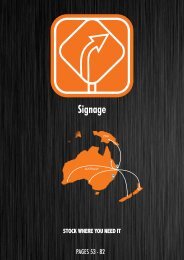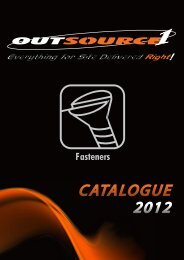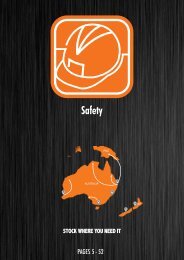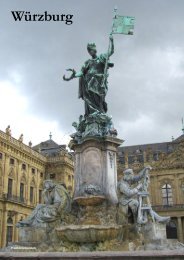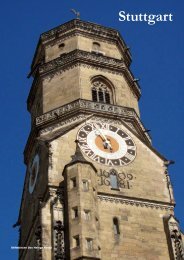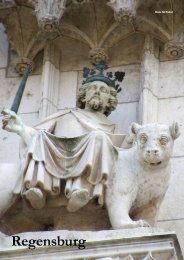Raven Guides: Germany - Trier
- No tags were found...
You also want an ePaper? Increase the reach of your titles
YUMPU automatically turns print PDFs into web optimized ePapers that Google loves.
The ZOB is outside the Hauptbahnhof at<br />
Bahnhofsplatz, serving local and regional<br />
buses as well as the AirPort Liner bus<br />
service to Luxemburg airport for European<br />
connections. MeinFernbus runs Luxemburg-<br />
Berlin via <strong>Trier</strong>, Kaiserslautern and Frankfurt<br />
(including a Frankfurt airport stop).<br />
The main streets of the centre city are<br />
pedestrian zones and most of the sights there<br />
can be reached readily on foot. The regional<br />
transport organisation Verkehrsverbund<br />
Region <strong>Trier</strong> (VRT, www.vrt-info.de) coordinates<br />
city bus transit and regional links.<br />
City buses run in a square around the<br />
inner city, converging on Porta Nigra, the<br />
Hauptbahnhof, the Kaiserthermen at the south<br />
corner and the intersection of Südallee and<br />
Kaiserstraße, branching to surrounding areas.<br />
Daylight services (to 18.45) are replaced by<br />
night buses (numbers 81-87) that converge on<br />
the Hauptbahnhof.<br />
For bus information and handy guides visit<br />
the SWT Stadtbus Center (M-F 8.30-18, Sa<br />
10-15.30), Treveris Passage 16<br />
Taxis gather at the Hauptbahnhof main<br />
entrance. To order tel 0651-12012, 0651-<br />
462946 or 0651-48048.<br />
The city is readily navigated by pedal.<br />
Bicycle rental (from €12 per day, €22 two<br />
days, €51 per week) is available at RadStation<br />
(tel 0651-148856, mid Apr-early Oct M-Su<br />
9-18, early Oct-mid Apr M-F 10-18, Sa 10-14)<br />
at the Hauptbahnhof. Long-distance bicycle<br />
paths run north-south on both banks of the<br />
Moselle.<br />
Street numbers in the city centre are<br />
sequential up one side and down the other.<br />
<strong>Trier</strong>Card & AntikenCard<br />
The three-day city tourist card (€9.90 or<br />
families with three children under 15,<br />
€21) allows free transport on the city bus<br />
network, minimum 25% discount on museum<br />
admissions (except the Landesmuseum, 10%,<br />
or for special exhibitions), 25% discount on<br />
guided walks or coach tours from Tourist<br />
Information <strong>Trier</strong>, 10% on Roman adventure<br />
performances, 25% on Kolb river cruises (see<br />
below) and other discounts including bicycle<br />
rental.<br />
<strong>Trier</strong> AntikenCard (€9 basic, including up<br />
to four visitors under age 18) covers admission<br />
to the Landesmuseum and two Roman<br />
structures in the city. AntikenCard premium<br />
(€14) covers all four Roman buildings in the<br />
city, the nearby Otrang villa and hermitage<br />
cell in Kastel). Both carry small additional<br />
discounts for other attractions and are valid for<br />
a year.<br />
Tours<br />
Round trips on the tourist train Römer Express<br />
(35 minutes, €9/4.50, families €22) depart<br />
from Porta Nigra (Apr-Oct M-Su 10-18 every<br />
25 minutes, Mar & Nov-Dec M-F hourly, Sa-<br />
Su every 30 minutes, Jan-Feb Sa-Su 10-17<br />
weather permitting). Recorded multilingual<br />
commentaries are offered on board. Tickets<br />
are available from Tourist Information <strong>Trier</strong><br />
nearby or the conductor.<br />
<strong>Trier</strong> CitySightseeing offers a hop on-hop<br />
off bus tour with multilingual commentary<br />
(Apr-Oct M-Su 10-17) leaving half-hourly<br />
from Porta Nigra with six stops near key sights.<br />
Tickets (€11/5) are valid for 24 consecutive<br />
hours.<br />
A 75-minute city walking tour (May-Oct<br />
The layout of the early 13th century Liebfrauen-Basilika<br />
(M-Su 10-19 except during services) is cruciform in basis<br />
but the rose-shaped plan represents the Virgin to whom<br />
it is dedicated. Linked via its north portal and cloisters<br />
to the cathedral, it is claimed as the oldest of <strong>Germany</strong>’s<br />
Gothic churches and replaced a church built in the<br />
Roman period. The French architects showed their<br />
influence in the style and decoration and lengthy<br />
restorations in recent years have brought the interior<br />
vault paintings and pillar paintings, showing the<br />
Apostles, back to full glory. Take bus 2, 10, 30, 33 or 87<br />
to Konstantin-Basilika.<br />
The facade of the town palace of an aristocratic<br />
family is displayed by the Kesselstatt<br />
Palais (1745) near the Liebfrauen-Basilika. The<br />
architect Johann Valentin Thomann was forced<br />
to design ingeniously to fit the unusually shaped<br />
but nonetheless premium site in the cathedral<br />
sector. The palace, with Baroque and Rococo<br />
features, required extensive reconstruction after<br />
heavy World War II damage that wrecked the<br />
interior. A wine cellar still bearing the<br />
baronial Kesselstatt name is in the adjacent<br />
abbey house. Take bus 2, 10, 30, 33 or 87 to<br />
Konstantin-Basilika.<br />
<strong>Trier</strong>’s episcopal centre is the oldest north<br />
of the Alps and one of the early Christian<br />
sites of <strong>Germany</strong>. A 4th century Roman<br />
twin basilica complex completed by the<br />
emperor Gratian predated the Dom St<br />
Peter (Apr-Oct M-Su 6.30-18, Nov-Mar<br />
M-Su 6.30-17.30). The remains of these<br />
first buildings have been excavated beneath<br />
and a square of the Roman period, around<br />
the altar, forms the kernel of the present<br />
church. The 11th century Romanesque nave<br />
and choir were added to the west. A late<br />
Romanesque apse and the Baroque Heiliger<br />
Rock chapel (open once a year) for the<br />
Holy Robe were later attached. The robe,<br />
claimed as that of Christ and brought from<br />
Jerusalem by the emperor Constantine’s<br />
mother St Helena, is rarely viewed. The<br />
east crypt contains a reliquary to the saint<br />
and mother and son are represented by<br />
statues. The so-called Domstein, part of a<br />
granite Roman pillar, lies outside near the<br />
foot of the taller south-west tower, elevated<br />
in 1515. Guided tours in English of the<br />
cathedral, the adjacent Liebfrauen-Basilika<br />
or the site’s Roman archaeology are by<br />
arrangement only at Dom-Information<br />
opposite. Take bus 2, 10, 30, 33 or 87 to<br />
Konstantin-Basilika.<br />
The elegant Walderdorff Palais at Domfreihof<br />
opposite the cathedral is named for the archbishop<br />
Johann Philipp von Walderdorff, who<br />
commissioned a cathedral deanery by Johannes<br />
Seiz in 1765. But it is successor to much older<br />
buildings, including the Roman basilica complex.<br />
The 11th century Turm Jerusalem in the rear<br />
courtyard is one of a handful of medieval tower<br />
residences known to have been built using old<br />
Roman stones and might have been five storeys<br />
high. The French used the palace as a<br />
government building in the Napoleonic period<br />
before the Prussians took it over. Take bus 2, 10,<br />
30, 33 or 87 to Konstantin-Basilika.<br />
<strong>Trier</strong> 4 - RAVEN TRAVEL GUIDES GERMANY








